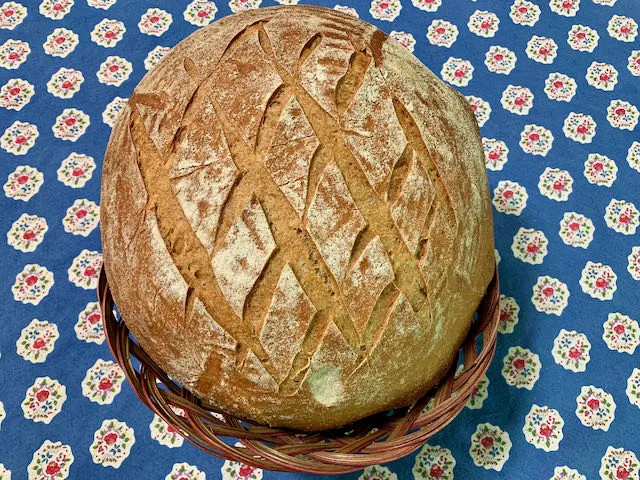
I haven't made a miche in a very long time. Last week, I got a bag of high extraction ("Type 80") flour from Central Milling and remembered that I had previously (like 11 years ago!) used this kind of flour for a miche based on the San Francisco Baking Institute formula that I liked a lot. We had made this bread for the Artisan II (Sourdough) workshop. Although we used white flour, our instructor told us that, ideally, it would be made with a high-extraction flour. My experience indicates this formula makes delicious bead either way. The main difference, besides flavor, is that using a high extraction flour results in significantly faster fermentation.
Miche from SFBI Artisan II
David Snyder
Total Dough | Bakers % | Weight (g) |
High extraction Flour | 96.67 | 1087 |
WW Flour | 3.33 | 38 |
Water | 73.33 | 824 |
Salt | 2 | 23 |
Wheat germ toasted | 2.5 | 28 |
Total | 177.83 | 2000 |
Pre-ferment | Bakers % | Weight (g) |
High extraction Flour | 75 | 112 |
WW Flour | 25 | 38 |
Water | 100 | 150 |
Salt | 0 | 0 |
Liquid starter | 50 | 75 |
Total | 250 | 375 |
1. Dissolve the starter in the water and mix in the flour. Desired Dough Temperature: 78ºF.
2. Ferment for 8-12 hours.
Final Dough | Weight (g) |
High extraction flour | 975 |
Water | 675 |
Salt | 23 |
Wheat germ toasted | 28 |
Levain | 299 |
Total | 2000 |
Procedure
- Dissolve the levain in the water. Add the other ingredients and mix thoroughly by hand. DDT: 75-78ºF.
- Transfer the dough to a clean, lightly oiled bowl.
- Ferment for 3-4 hours with 4 folds at 50 minute intervals. (I did this by the “stretch and fold in the bowl” technique.)
- Transfer the dough to a lightly floured board. Pre-shape as a tight boule.
- Cover and let rest for 20-30 minutes to relax the gluten.
- Shape as a tight boule and place, seam side up, in a floured banneton.
- Cover and retard overnight in refrigerator.
- Remove the boule from the refrigerator and allow to warm and complete proofing for 1-3 hours. (Watch the dough, not the clock!)
- 45-60 minutes before baking, pre-heat the over to 500ºF with baking stone and steaming apparatus in place.
- When the loaf is proofed, transfer the boule to a peel. Slash the boule as desired, and transfer it to the baking stone. Steam the oven and reduce the temperature to 450ºF.
- Bake for 20 minutes, then remove your steaming apparatus.
- Turn the oven down to 425ºF.
- Continue baking for another 40-50 minutes.
- Remove the boule to a cooling rack, and cool thoroughly before slicing.
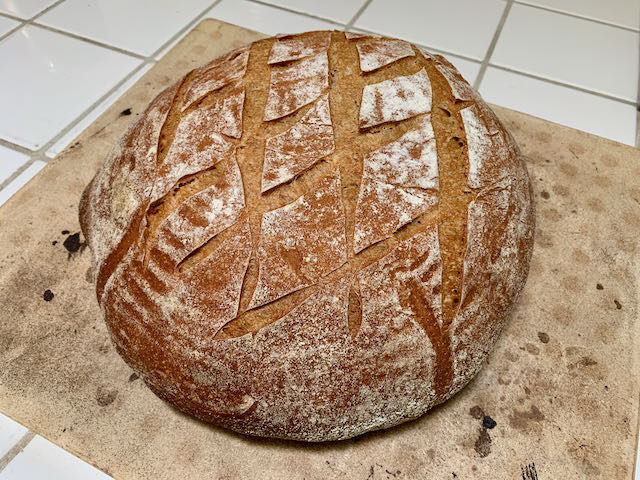
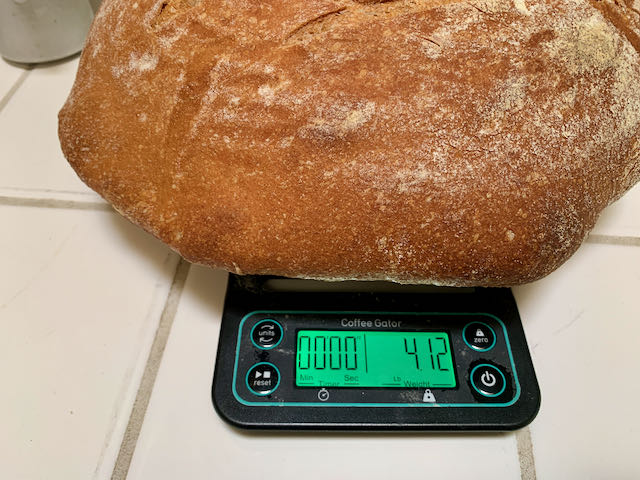
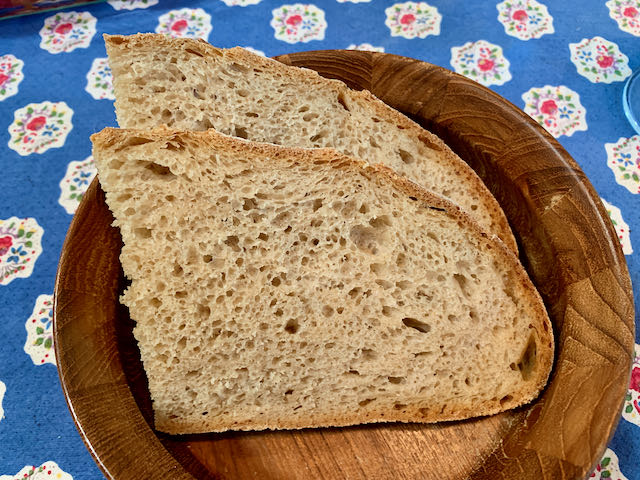
This bake (in my relatively new oven) was less bold than expected. I will finish the bake at a higher temperature next time.
The crust was mostly chewy. The crumb was moist and tender. The flavor was mildly sweet and wheaty. My recollection is that the flavor of these large loaves improves significantly over the first 2 days.
I enjoyed a couple still-warm slices with a little sweet butter with dinner.
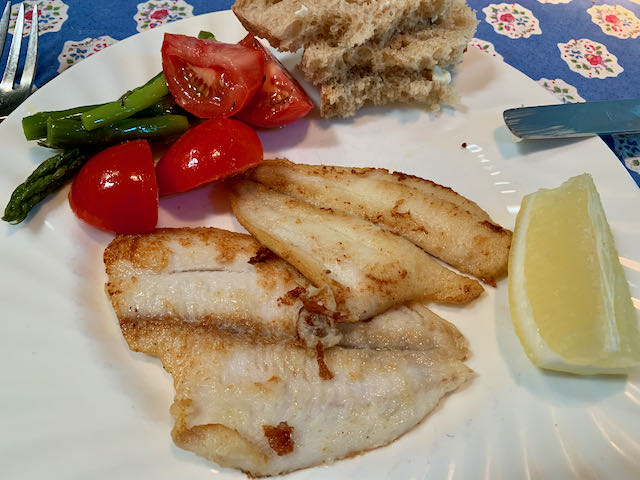
Enjoy!
David
- dmsnyder's Blog
- Log in or register to post comments
Very impressive loaf with a lovely crumb. The addition of toasted wheat germ would add to the flavour and work well with the high extraction flour I'm guessing. Thanks for sharing the formula and process.
Cheers,
Gavin.
Really lovely crumb you’ve achieved there David, really nice especially given the high extraction flour used and wheat germ added. Nice fish dinner as well.
Benny
David, you knocked that one out of the park! That crumb shot looks kind if “Pipish” to me. :-)
It appears from your crumb shot, that the loaf stood very tall. What size proofing basket did you use?
How do you preserve the bread from staling? It’s a giant!
Thank you David. KAF Organic T85 HE flour is available from our local coop (50 lb bag minimum). Look forward to trying this WE.
I don't recall ever seeing KA T85 for sale in their web store. I'd love to try it, but not starting with 50lbs!
FYI, the other miche I have made and really enjoyed was the James MacGuire formula Jeff Hamelman has in "Bread."
Happy baking!
David
@ Dan. Good questions. I used a 10" linen-lined banneton, hoping to get a less flat loaf. The loaf really filled the banneton after the overnight retardation. I also shaped the boule really tight. In the past, I have used a 12" banneton for miches.
With large loaves like this, I cut them in quarters, wrap each in plastic freezer wrap and freeze in a plastic bakery bag. I thaw a quarter at a time. Realize each quarter weighs a pound.
David
David, what would you estimate the max dough weight for the 10” basket? If you remember, I bought the SFBI 8,10, & 12” baskets on your recommendation. Very pleased with them.
Well, this miche was about 2kg before baking, and it was probably at the maximum the 10" banneton could accommodate. I believe the recommendation for the 10" is 2-2.5 pounds of dough. The 12" can handle 4 -6 pounds of dough, I think.
A few months ago, I washed the liners in place. They had a lot of crusted flour. They dried quickly in our climate.
David
Beautiful miche Dr S.. Good to hear from you as always. I well remember your original posts on SFBI miches (“This Miche is a Hit!” If I recall), wheat germ and all. Probably had a greater influence than I know on my now well established habit of baking almost exclusively a weekly 2kg miche.
That you have a new-ish oven is apparent from the crust not instantly identifiable as the signature Snyder Chestnut hue, further supporting your note that oven variation contributes substantially to breads’ highly personal terroir.
Looks delicious. Take care and buon apetito.
Tom